Pinnipeds of the Salish Sea
The Salish Sea is one of the most active sanctuaries for an abundance of marine wildlife. Amidst the thrill of whale watching, Anacortes is a fantastic launch point for seeking to spot several other mammals during our wildlife tours. Part of what actually draws our infamous Bigg’s Killer Whales to this region is the bounceback in the population of pinnipeds following the 1972 Marine Mammal Protection Act. Today they are frequently spotted along “haul out sites”– rocky shores or islands– that are also often protected as National Wildlife Refuges.
What is a Pinniped?
The word “pinniped” literally translates to “fin-footed” describing the amphibious (water and land dwellers) that use their fins to swim as well as hobble along the shore. The main types of pinnipeds that we encounter in the Salish Sea include Harbor Seals, Steller Sea Lions, and California Sea Lions. All of these species are known to “haul out” to rest, breed, or just warm their blubber from the cold Northern waters. They also tend to have a high fidelity in returning to specific rookeries, especially for pupping season. At a glance these individual species can seem quite similar, yet they are each very unique once you get to know more about their features, sizes, movements, and behaviors.
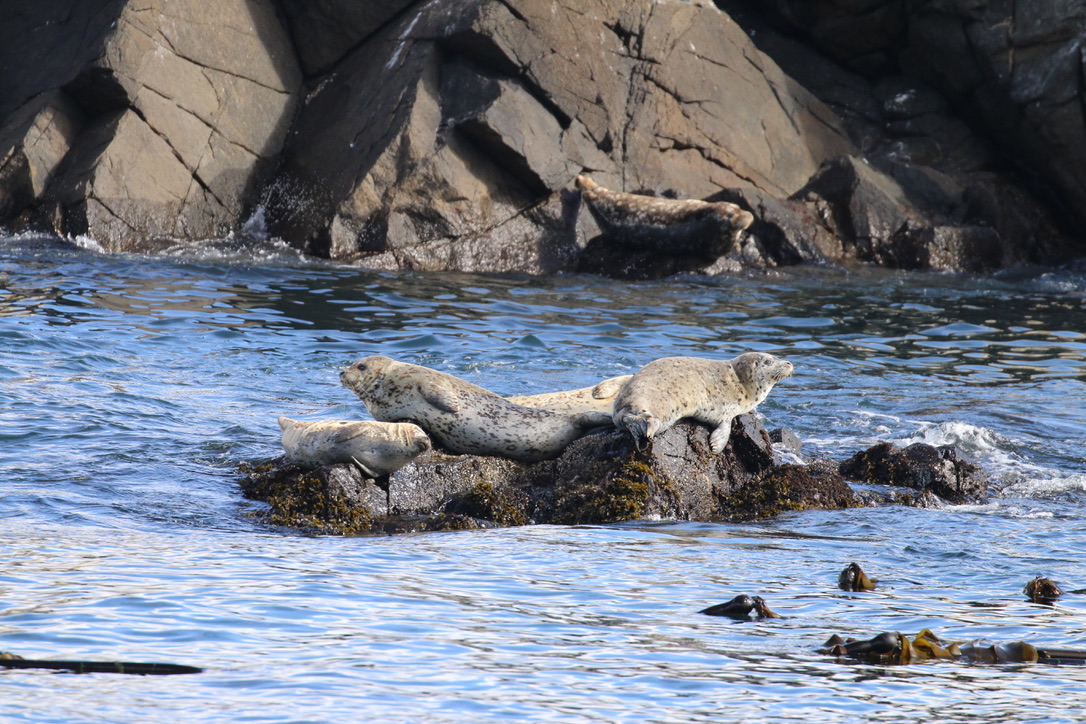
Harbor seals hauled out, Photo Credit: Blue Kingdom Tours
Seals- Adorable and “Earless”
Speckled along the rocks and coastal shores, seals come in a variety of colors including black with spots, brown, or grayish-white. Oftentimes this can depend on the region and the rocks that they may camouflage against to hide from predators. The majority of our local seals are the Harbor Seals, however we are seeing an upswing in more Elephant Seals to the region.
Similar to most pinnipeds, seals are considered “generalist eaters” meaning they scoop up all sorts of seafood! Commonly they feed on medium-sized schooling fish such as herring, mackerel, sardines, anchovies– about 48 species of fish and invertebrates that they welcome into their diet.
Distinct in that they are “earless” or do not display any external ear flaps, seals actually have a very keen ability to hear. This is especially recognized while diving underwater using this sense to hunt or avoid predators. Seals have been observed responding to sounds above water between 1 kHz to 22.5 kHz and increasing to high frequencies from 1 kHz up to 180 kHz underwater.
Perhaps their precise hearing and sensitive whiskers help to compensate for their poor eyesight and agility on land. In the water, their hind flippers act as a great propeller and their foreflippers as rudders for steering. Their pelvic bones however are fused meaning they don’t have the ability to walk or waddle on land and instead move in an undulating “worm-like” motion, flopping along on their bellies.
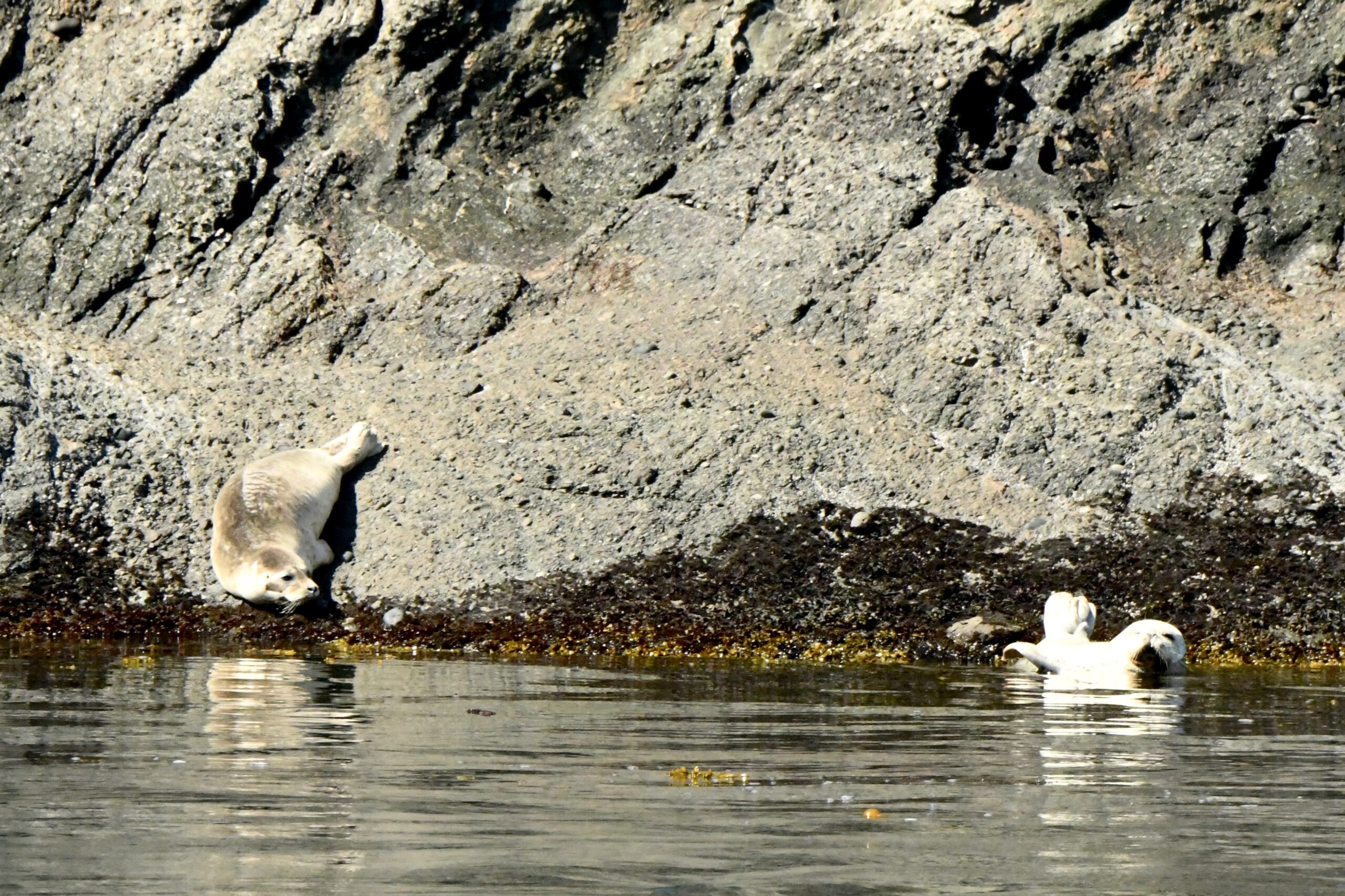
Harbor seals enjoying the sun, Photo by: Blue Kingdom Tours
Harbor Seal
As a smaller pinniped, they range fairly close to or slightly smaller than an adult human, measuring around 4.5-5.5 feet on average. However, their weight can range quite a bit between 95-300 pounds depending on male/ female and availability of prey. A rare phenomenon after harrowing times, our Harbor Seals have made the most impressive comeback, with populations that have been far exceeding the pre-culling numbers.
Elephant Seal
Elephant Seals are about double to triple the size of Harbor Seals and weigh about 14 times as much– males can sometimes be up to 4,400 pounds! The males also develop the large signature nose (called a proboscis) at about 7 years when they hit puberty. This hangs like an elephant trunk just about 8 inches over their lower lip and is buoyant in water. Their proboscis is used to resonate sound when they are establishing their territory especially during breeding season. A little silly in appearance, but somehow super endearing at the same time!
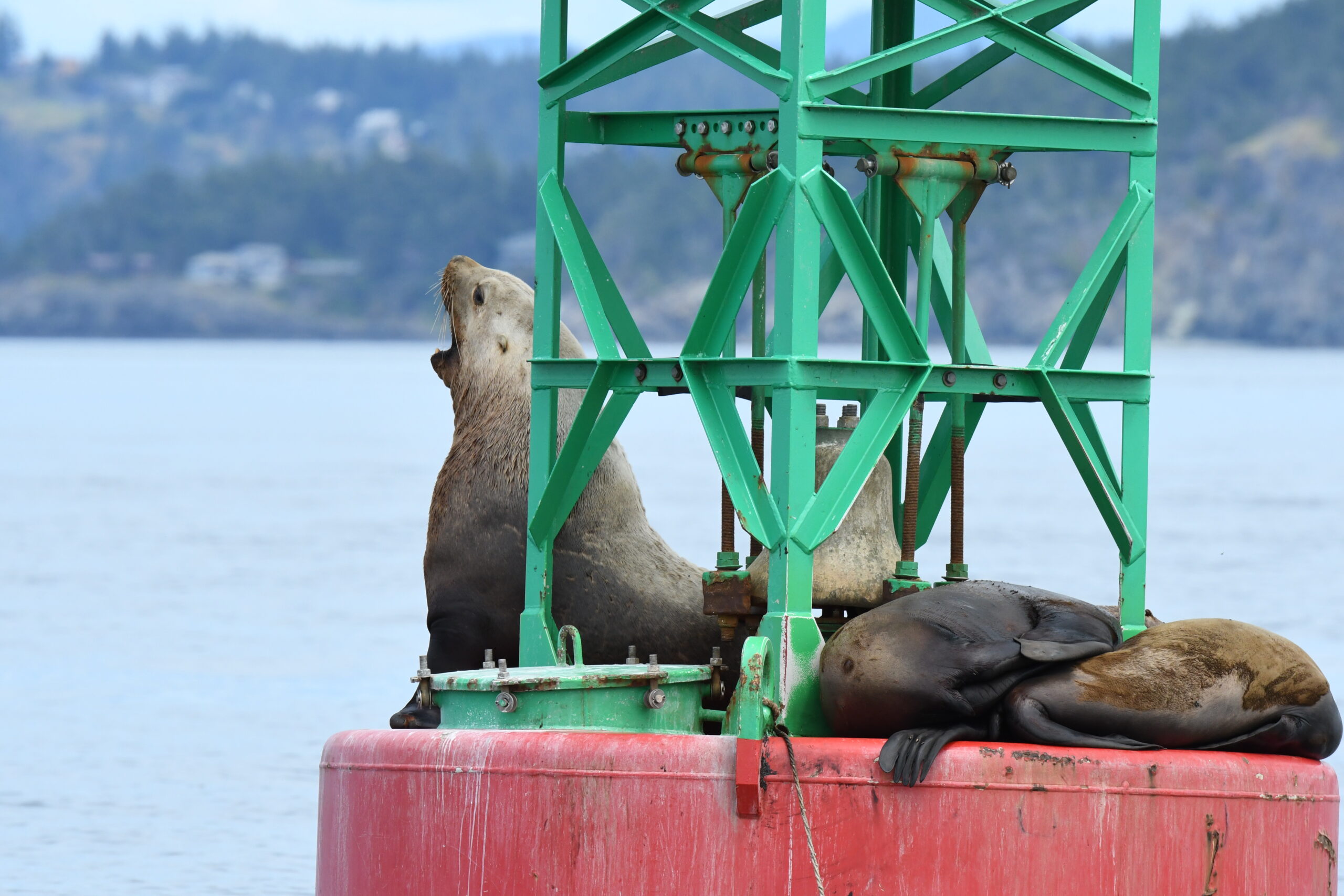
Stellar Sea Lions, Photo Credit: Blue Kingdom Tours
Sea Lions- Vocal and Robust
In the Salish Sea, we are fortunate enough to encounter two species of Sea Lions, the Steller Sea Lion and the California Sea Lion. Booming with barking or roaring noises and territorial activities, Sea Lions put on quite the show! During pupping season, the males will defend the rookeries often not leaving their territories for over 2 months.
Sea Lions are also “generalist” eaters, feeding on medium or larger schooling fish depending on what is available regionally. Unlike Harbour Seals, Sea Lions do have defined ear flaps and an ability to alternate movement of their flippers, producing a waddling movement while on land.
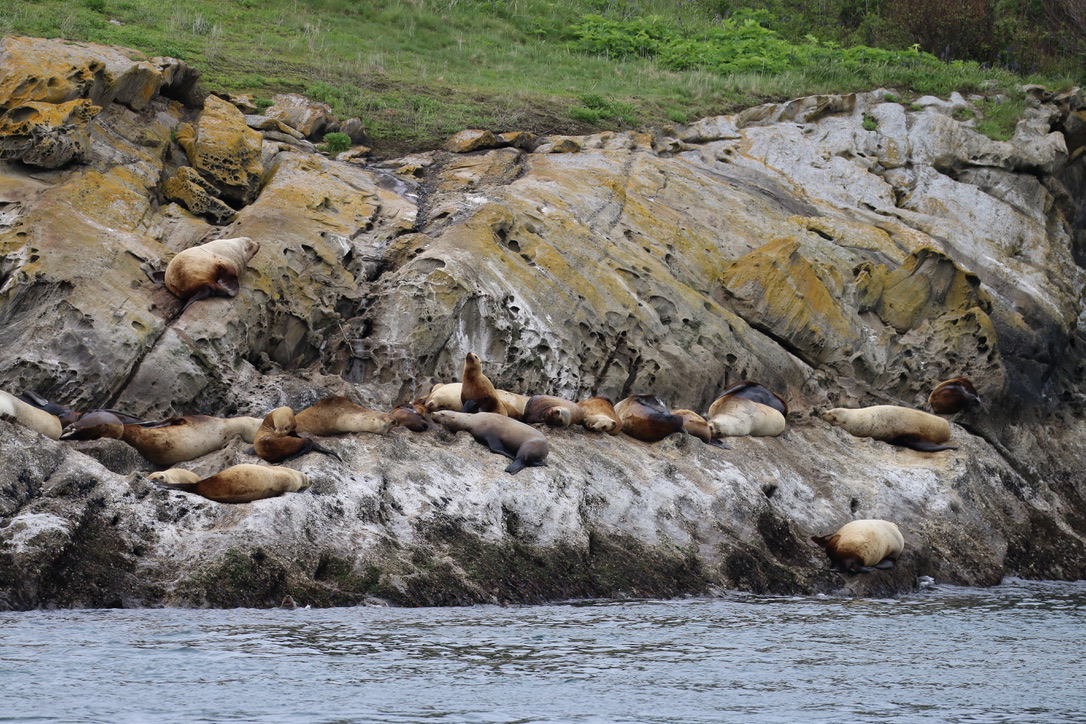
Stellar Sea Lions, Photo Credit: Blue Kingdom Tours
Stellar Sea Lion
The largest of our local pinnipeds, Steller Sea Lions exhibit a significant sexual dimorphism. The males are generally bulkier, weighing between 880-2,400 pounds and about 9-10 feet long, whereas the females average around 450-650 pounds and 7-8 feet in length. The fully mature males also develop a thick neck, blonde mane, and broad forehead clearly providing distinction between males and females similar to that of an actual lion. Likewise, their particular “roar” is easily notable in contrast to other pinniped vocalizations.
California Sea Lion
Generally the California Sea Lions that visit the Salish Sea are predominantly males as the females remain close to their breeding grounds in California. This seems to be a recent development as the species may be seeking new areas to colonize. Smaller than their cousins, but larger than seals, California Sea Lions average around 5-8 feet and weigh around 200-800 pounds. There is a slight sexual dimorphism in the sizes of males vs. females, just not quite as drastic as it is recognized with Steller Sea Lions. Acoustically, they produce more of a “barking” noise, making quite the authentic “seaside chorus,” especially when joined by a flock of gulls.
Culling and the Current Conservation of Pinnipeds
Prior to the Marine Mammal Protection Act of 1972 (MMPA), most pinnipeds in the Salish Sea had been considered a “nuisance species” and were actively culled (hunted or captured) by humans since the early 1900’s. This reduction in the population left most rookeries almost completely devoid of Seals and Sea Lions for decades. Fortunately, the populations have recovered or are actively recovering due to the MMPA. Remaining threats to these species include fishing entanglement, pollution, and increased vessel traffic.
Recent discussions on future cullings also propose challenges in continuing to protect our pinniped friends. Some imply that the “generalist” diet of pinnipeds is further depleting the already threatened local salmon species. Others suggest that nature will take care of itself without human intervention. These theories note that the growing pinniped population has led to the arrival of more pinniped predators (aka Bigg’s Killer Whales.) As a result, the hope is for this to naturally bring balance back to the food chain and keep all of our marine wildlife protected. Our wildlife tours are designed to bring awareness to the advancement of these pinnipeds and further support their environment.
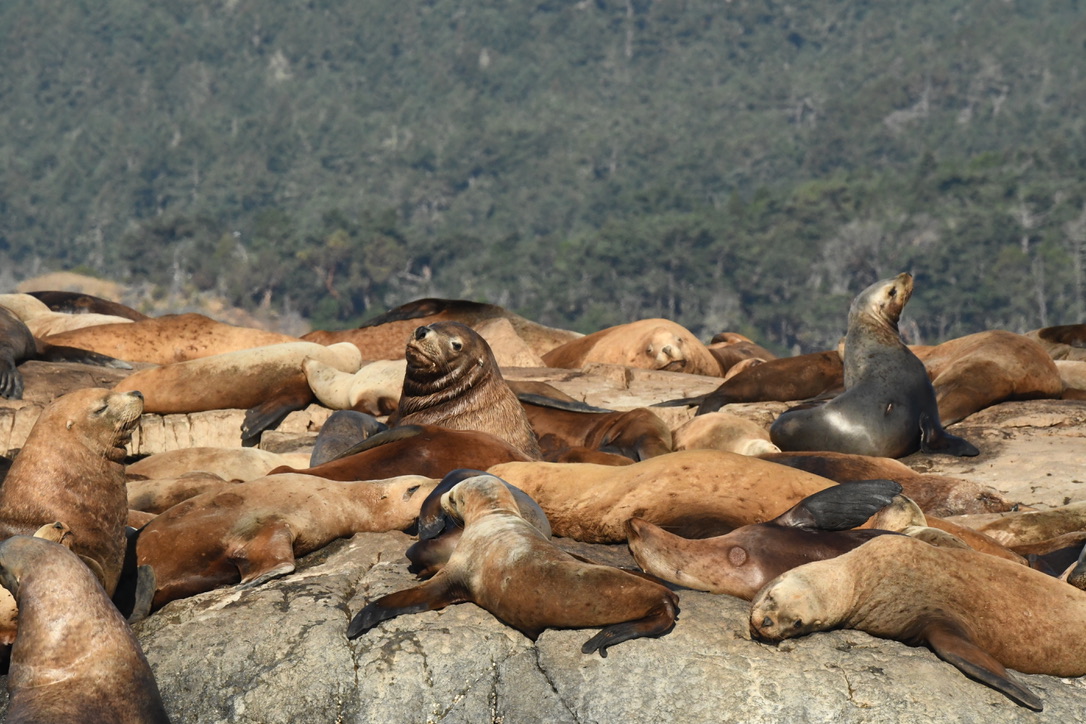
Stellar Sea Lions,Photo Credit:Blue Kingdom Tours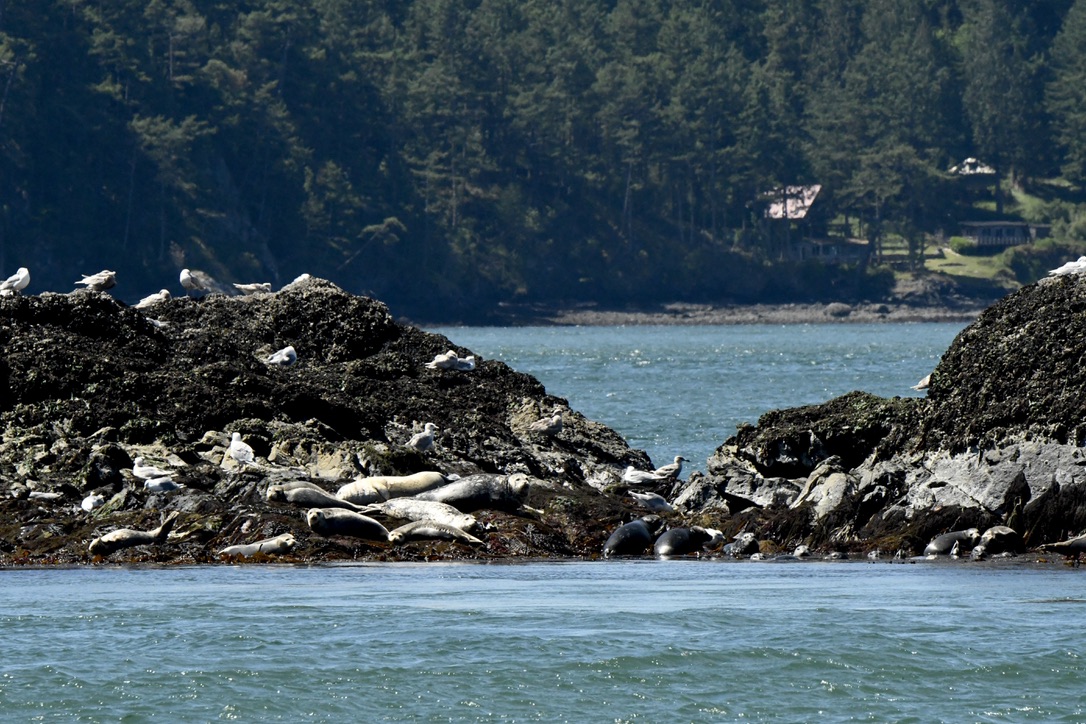
Harbor Seals, Photo Credit: Blue Kingdom Tours
References:
Strawberry Isle Marine Research Society, Quick Facts: A Guide to Marine Mammals, accessed May 26, 2023, <www.simrstofino.org>
The Great State of Alaska, Harbor Seals Species Profile, Department of Fish and Game, accessed May 26, 2023, <https://www.adfg.alaska.gov/index.cfm?adfg=harborseal.printerfriendly>
NOAA Fisheries, Species Directory: Steller Sea Lion, U.S. Department of Commerce, accessed May 26, 2023, <https://www.fisheries.noaa.gov/species/steller-sea-lion>
NOAA Fisheries, Species Directory: Northern Elephant Seal, U.S. Department of Commerce, accessed June 2, 2023, https://www.fisheries.noaa.gov/species/northern-elephant-seal
Puget Sound Institute 2012-2023, Encyclopedia of Puget Sound, University of Washington, accessed June 1, 2023, <https://www.eopugetsound.org/terms/404>

